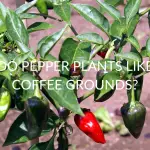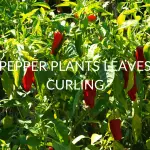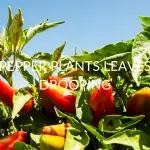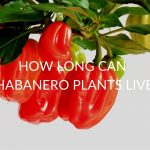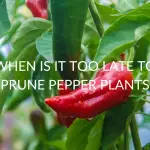Pepper plants are hardy, fruit-producing plants that make an incredible addition to any outdoor garden. They can be potted or grown directly in-ground and thrive in hot, dry temperatures with direct sunlight. But how long can pepper plants go without watering? In this article, we’ll explore how often you need to water them, how to keep them alive, and what to do if your peppers get too dry.
How Long Can Pepper Plants Go Without Water?
Pepper plants can survive without water for a little over a week with proper preparation. This includes mulching, creating shade, and deep watering. If the peppers don’t receive preparation, they can begin to die as quickly as five days in the Spring and Fall and 2-3 days in hot summers.
Sweet peppers need more frequent watering and can severely wilt if unattended for a week, while chile peppers thrive in hot environments and will perk up after one deep water a week. You need to water Ornamental pepper plants once every 2-3 days.
Do Pepper Plants Need Water Every Day?
Pepper plants need to be watered every 2-4 days in the Spring and Fall and every 1-2 days in hot summers. There may be days you need to water the peppers every day, but only when the soil is completely dry.
A good rule is to allow the soil to dry completely before the next watering. If your schedule is thrown off because of a heavy rainstorm or you missed a day, check the soil at different depths to determine how much water the plant needs.
I use a popsicle stick to measure my soil’s dampness. I place the stick halfway into the soil and let it sit. If the entire bottom half is damp, I don’t water it. If it’s partially wet, I water it a little. If it’s completely dry, I water it thoroughly.
How To Keep Peppers Alive For Longer Without Watering
Whether you plan on going away or you want to save on your water bill, there are a few ways to ensure your peppers will stay alive and healthy with less water. Some of these tips encourage less watering, while others encourage small waterings daily. All will result in less water usage overall.
Improve Soil Quality
Before planting your peppers, add cow manure, compost, and worm castings to the soil before tilling it well. Adding hay can also encourage water retention and a breakdown into healthy, organic matter. The soil will not only feed the plant, but it will hold water without rapid drainage.
Mixing Miracle-Gro watering crystals and moisture-controlled potting mix into your soil is an easy, efficient way of improving soil quality without sourcing manure or worms. The water storing crystals absorb the water in the ground and then release it as needed. This helps prevent overwater and underwatering.
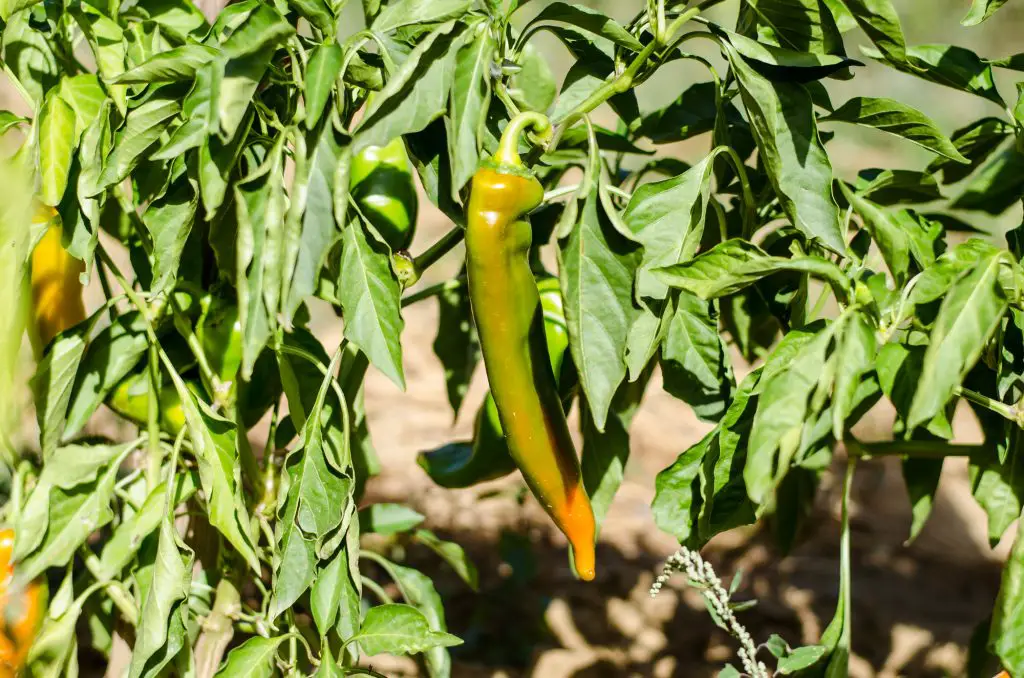
Cover with Mulch
Mulches with hay or sugar cane are the best options as they hold water within their plant fibers and create a protective barrier from the sun. Aim for 3-4 inches of mulch to hold the water in for longer. Don’t only mound the mulch around the plant’s base – spread it about equally throughout the pepper bed to ensure the most soil stays damp.
You can mulch potted plants, too. When potting, remember to set the soil lower in the pot than you typically would (leaving around 3 extra inches on top). This way, there’s plenty of room for the mulch in the pot without burying the entire pepper plant.
Move Peppers to the Shade
With potted peppers, moving them to the shade is a great short-term solution if you’re going away for a week. I say short-term because pepper plants need direct sunlight to flourish fully, but a week won’t hurt them.
If your peppers are in the ground, consider creating a shade cover for while you’re gone. It’s simple to make, and you can find gardening poles and burlap at your local home improvement store. Remember that this shade protection will also limit how much natural water your plant gets if it rains.
Deep Watering
Deep watering the plants and the mulch the morning before you leave ensures the plants will stay damp while you’re gone. The mulch will hold onto the water and slowly release it into the ground as the plant dries the soil beneath.
If your plant is potted, deep watering won’t work as well because the water has nowhere to go. Investing in a slow plant waterer can give you peace of mind that your plants will be watered little by little every day. You can even make your own using old soda bottles.
Prepare the Plant
You can encourage deep root growth in in-ground plants by deep water once a week and then holding off on watering again. Over time, the plant’s roots will reach further down. The more expansive root system allows the plant to maintain water longer.
This also helps to prevent over-watering, meaning you can pour a lot of water on the plants just before you leave, and they’ll be fine. This method doesn’t work well with potted plants because the roots have nowhere to go, and the plant can end up pot-bound.
What To Do If Peppers Get Too Dry
Pick Any Peppers
Picking peppers reduces the nutrient stress on the plant and encourages the plant to expend energy on reviving instead of producing. Don’t worry if you’re not ready to use all those peppers – they can be dried and used all year long. If the plant is too dry during the flowering phase, you may have to pick off the weakest flowers to ensure the stronger ones survive.
Add Mulch
If there wasn’t already straw mulch, add some now. This will protect the soil from losing water and help retain moisture after the first deep watering. If there was mulch but it’s gotten old, you can till it into the soil and lay down fresh mulch. It will break down just like any other organic material.
Water Deeply, Then Wait
Dry soil has trouble absorbing water. You may have seen this when you tried to water a plant and the water pools on top. The best thing to do is to give it way more water than you think it needs and then let it sit. Two things can happen:
- The water will drain directly out the bottom
- The water will sit on top and slowly absorb into the soil
If it drains directly out the bottom, wait fifteen minutes and then try again. If the water slowly absorbs into the soil, wait fifteen minutes and give it much less water. This is to check that the soil can absorb water again.
Prune Dead Leaves/Stems
Like removing peppers, pruning dead leaves and stems encourages the plant to expend energy rejuvenating. Prune from the bottom of the plant to the top. This is because the leaves at the top of the plant receive the most sunlight and are able to make the most food.
You can toss the pruned leaves and stalks onto the ground beside the plant for additional nutrients. Any plant matter will break down and help create an extra layer of protection (if you don’t mind your garden looking a little messier).
How Often To Water Pepper Plants
If you’re not leaving for a trip and are looking to lower your water bill, this section will explain when to water your plants and the signs to look out for. Different watering intervals are based on the environmental season and whether you’re growing sweet or hot peppers.
When The Leaves Droop
When the leaves and stems begin drooping, your plant is ready to be watered. This can be anywhere from 2-5 days apart, depending on soil quality, outdoor conditions, and the type of pepper plant. The stems will also begin drooping, and the leaves may turn yellow and brown. This means the plant is too dry, and you waited too long to water it.
When The Weather Isn’t Cooperating
Peppers can suffer from “temperature stress” and consume more water if the heat index rises too high. Generally, you should water the plants more frequently if the temperature is steadily over 80 F. You should also move potted plants to partial shade.
Plants can also lose water if there have been high winds. The wind will dry out the stems and leaves and “pull” water out of the plant’s cell membranes. If you’ve ever stood in front of a fan for a long time, you may notice your face is drier or your eyes hurt. This is a similar situation.
In the Spring/Summer/Fall
In the Spring and Fall, you’ll need to water your pepper plants once every 2-5 days. If you live in a climate with hot and dry summers, you may need to water your plants every day. Rely on soil dampness more than a schedule if you’re not sure.
When You’re Growing Sweet Peppers
Sweet peppers require more water than hot peppers, and they’re more sensitive to changes in temperature. Because of this, sweet peppers need to be watered twice a day when the temperate is over 80 F and the plants are in direct sunlight.
If the temperature stays lower but the plants are outside, sweet peppers should still be checked daily to determine how much water they need. If growing them inside, sweet peppers need to be watered daily.
When You’re Growing Hot Peppers
When you restrict water access to hot peppers, the fruits become smaller, spicier, and have a higher flavor concentration. Due to this, many farmers purposefully underwater their hot pepper plants to achieve a more “punchy” pepper.
You’ll need to look for signs of underwatering, as that can kill the fruit instead of concentrating it. Water the plants once a week in Spring and Fall and twice a week in the summer. If your heat index rises above 90 F, check the soil daily and watch for leaves drooping to water the plant more often.
FAQ’s
How Do I Know If I’m Overwatering My Pepper Plants?
Overwatered plants will have consistently damp soil, drooping and yellowed leaves, stunted growth, and a lack of flowers/fruit. The plant will begin sagging, and mold may start growing on the base of the plant or the top of the soil.
Overwatering can lead to root rot, ultimately killing the entire plant. If you’re worried the plant has too much water to drain on its own, you can repot the plant into drier soil and water lightly.
How Do I Know If I’m Underwatering My Pepper Plants?
Underwatered plants have dry soil that struggles to take water, drooping, browned, and curled leaves, dying branches, and flowers/fruit falling off. The leaves will feel paper thin and dead, while the stalk and stems will feel brittle.
If the lower leaves are dying and falling off, this is another sign of underwatering. If the plant is in a pot, check to ensure the plant isn’t root-bound, as root-bound plants exhibit many of the same characteristics.
How Often Do You Water Pepper Plants Indoors?
Keeping your pepper plants inside can be a massive advantage if you live in extremely hot or cold climates. As long as the plant gets enough light (from either a south-facing window or a grow light), it’ll flourish year round. Because the air in houses tends to be drier, it’s recommended to water more frequently.
Small waterings daily can provide the best results in sweet peppers, while small waterings every few days are best for hot peppers. Fun fact: Unlike other fruit-producing plants, peppers are self-pollinating. This means that a single plant or single flower can set fruit by itself, making them ideal for indoor gardening.
Conclusion
Pepper plants are hearty vegetable plants that can continue to produce peppers for numerous years if treated correctly. They’re highly susceptible to overwatering but can withstand more extended periods of drought because of their native locations.
If you’re looking to water your pepper plants less often, you can enrich the soil, lay down a mulch cover, deep water once a week, and encourage root growth.


